MODEL RESULTS -
PLIOCENE CONTROL
Surface Temperature Difference
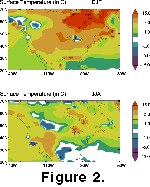 The
HadAM3 model predicts a distinct warm anomaly over the USA during the middle
Pliocene (Figure 2). This anomaly is
visible over the annual cycle and during winter (DJF) and summer (JJA)
intervals. The geographical distribution of the warming is remarkably
continuous. Annual mean temperature (DT)
changes show an average increase of 2º to 5ºC. Surface temperature increases
are highest during the DJF period with DT
values of + 5º to 10ºC common over most interior regions of the USA.
Temperature variations of above 20ºC during DJF are also predicted for the
Hudson Bay region of NE North America. Surface temperature changes during JJA
reveal a less consistent pattern of change. Overall, a warming of 2º to 5ºC is
predicted over many areas of the USA. However, larger
The
HadAM3 model predicts a distinct warm anomaly over the USA during the middle
Pliocene (Figure 2). This anomaly is
visible over the annual cycle and during winter (DJF) and summer (JJA)
intervals. The geographical distribution of the warming is remarkably
continuous. Annual mean temperature (DT)
changes show an average increase of 2º to 5ºC. Surface temperature increases
are highest during the DJF period with DT
values of + 5º to 10ºC common over most interior regions of the USA.
Temperature variations of above 20ºC during DJF are also predicted for the
Hudson Bay region of NE North America. Surface temperature changes during JJA
reveal a less consistent pattern of change. Overall, a warming of 2º to 5ºC is
predicted over many areas of the USA. However, larger  T
variations of 5º to 10ºC are restricted to the Great Plains region. Predicted
sporadic cooling over isolated areas of the USA during the middle Pliocene is
caused by differences in the assigned position of the coast specified in the
PRISM2 data set.
T
variations of 5º to 10ºC are restricted to the Great Plains region. Predicted
sporadic cooling over isolated areas of the USA during the middle Pliocene is
caused by differences in the assigned position of the coast specified in the
PRISM2 data set.
Temperature Forcing and Feedbacks
Lower terrestrial ice cover in the Northern Hemisphere and higher SST in the
North Atlantic-North Pacific provide the initial forcing mechanism behind the
predicted surface temperature increases over the USA at 3 Ma B.P. However,
reductions in albedo, particularly during DJF generated by reduced snow cover
and altered Pliocene vegetation distributions, would have caused an increase in
the absorption of solar radiation promoting further warming. 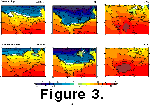 The
snow depth decrease occurs over the USA despite a general increase in wintertime
precipitation. An increased proportion of precipitation during the warmer middle
Pliocene simulation falls as rain and not as snow. Comparison of absolute
temperature patterns for present-day and the middle Pliocene over the annual
cycle, DJF and JJA, reveal interesting differences (Figure
3). During the middle Pliocene, the freezing line over the annual period and
DJF is positioned further to the north of the present-day position (~10ºN).
Furthermore, the pattern of decreasing temperatures with increasing latitude
during the middle Pliocene is less spatially variable than for present-day. This
is a function of the prescribed reduction in elevation (by 50%) of the western
cordillera of North America within the PRISM2 boundary conditions.
The
snow depth decrease occurs over the USA despite a general increase in wintertime
precipitation. An increased proportion of precipitation during the warmer middle
Pliocene simulation falls as rain and not as snow. Comparison of absolute
temperature patterns for present-day and the middle Pliocene over the annual
cycle, DJF and JJA, reveal interesting differences (Figure
3). During the middle Pliocene, the freezing line over the annual period and
DJF is positioned further to the north of the present-day position (~10ºN).
Furthermore, the pattern of decreasing temperatures with increasing latitude
during the middle Pliocene is less spatially variable than for present-day. This
is a function of the prescribed reduction in elevation (by 50%) of the western
cordillera of North America within the PRISM2 boundary conditions.
Variations in Precipitation and
Evaporation Rates
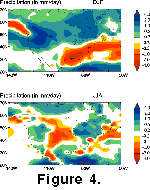 A
clear signal of changing precipitation rates over the USA during the middle
Pliocene is predicted by the HadAM3 model (Figure
4). Two zones of change are evident. Over the annual cycle and during winter
(DJF), northern parts of the USA experience more rainfall (+ 4.00 to 8.00
mm/day). This increase in precipitation occurs as a broad belt across North
America between 40º to 60ºN. This increase of precipitation is consistent with
an enhancement of the moisture bearing westerly winds over the USA during the
middle Pliocene. In the southern and central areas of the USA, particularly
during JJA, total precipitation rates decrease by an average 2.00 mm/day.
A
clear signal of changing precipitation rates over the USA during the middle
Pliocene is predicted by the HadAM3 model (Figure
4). Two zones of change are evident. Over the annual cycle and during winter
(DJF), northern parts of the USA experience more rainfall (+ 4.00 to 8.00
mm/day). This increase in precipitation occurs as a broad belt across North
America between 40º to 60ºN. This increase of precipitation is consistent with
an enhancement of the moisture bearing westerly winds over the USA during the
middle Pliocene. In the southern and central areas of the USA, particularly
during JJA, total precipitation rates decrease by an average 2.00 mm/day.
Changes in the pattern and amount of evaporation and humidity over the USA
are mainly a reflection of the altered precipitation distribution and warmer
surface temperatures. Areas experiencing enhanced precipitation via moisture
bearing westerly winds in the northern USA have elevated evaporation rates by as
much as 0.50 to 1.00 mm/day. This reflects the greater moisture availability for
evaporation and the warmer surface temperatures. Conversely, central and
southern parts of the USA have lower evaporation rates relative to present-day
(by a maximum of 4.00 mm/day during JJA) due to a decreased availability of
moisture. Humidity values also show a corresponding decrease by as much as 30
percent in this area during JJA.
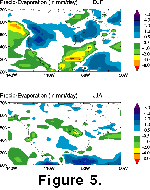 Precipitation
minus evaporation (P-E) changes over the USA, for the Pliocene control
simulation, indicates small anomalies compared to present-day model simulations
during JJA. However, significant anomalies are observed for the winter (DJF)
season (Figure 5). The model suggests
that for the northern USA, during the middle Pliocene, a substantially greater
(0.00 to 4.00 mm/day) precipitation flux existed compared to present-day. In
contrast, the southeast of the USA during DJF has a greater evaporative flux
(0.50 to 8.00 mm/day) compared to model simulations for the present, which
extends further south into the Gulf of Mexico. These P-E anomalies are a product
of the predicted Pliocene precipitation changes over the USA during DJF (see Figure
5).
Precipitation
minus evaporation (P-E) changes over the USA, for the Pliocene control
simulation, indicates small anomalies compared to present-day model simulations
during JJA. However, significant anomalies are observed for the winter (DJF)
season (Figure 5). The model suggests
that for the northern USA, during the middle Pliocene, a substantially greater
(0.00 to 4.00 mm/day) precipitation flux existed compared to present-day. In
contrast, the southeast of the USA during DJF has a greater evaporative flux
(0.50 to 8.00 mm/day) compared to model simulations for the present, which
extends further south into the Gulf of Mexico. These P-E anomalies are a product
of the predicted Pliocene precipitation changes over the USA during DJF (see Figure
5).
Precipitation Forcing and
Feedbacks
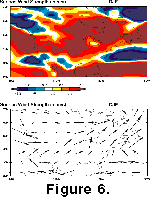 The
primary forcing mechanism, producing the altered precipitation pattern over the
USA during the middle Pliocene, is a strong increase in westerly wind strength (Figure
6). These enhanced westerly winds aid the transport of moisture that falls
mostly as rain because of the higher annual surface temperatures. The westerly
wind increase is brought about by a complex set of climatic feedbacks. Higher
SST in the North Atlantic-Pacific, combined with reduced ice cover in the high
latitudes of the Northern Hemisphere, deepen the Aleutian and Icelandic
low-pressure systems. This generates an enhanced pressure gradient between the
high latitude low pressure cells (Aleutian and Icelandic low-pressure systems)
and the subtropical high pressure cells (i.e., Azores high-pressure system)
intensifying westerly wind strength in the Northern Hemisphere, particularly
during winter. This aids in both the transport of heat and moisture and explains
why the highest magnitude changes in surface temperature and precipitation
during the middle Pliocene over the USA are predicted for the winter season.
The
primary forcing mechanism, producing the altered precipitation pattern over the
USA during the middle Pliocene, is a strong increase in westerly wind strength (Figure
6). These enhanced westerly winds aid the transport of moisture that falls
mostly as rain because of the higher annual surface temperatures. The westerly
wind increase is brought about by a complex set of climatic feedbacks. Higher
SST in the North Atlantic-Pacific, combined with reduced ice cover in the high
latitudes of the Northern Hemisphere, deepen the Aleutian and Icelandic
low-pressure systems. This generates an enhanced pressure gradient between the
high latitude low pressure cells (Aleutian and Icelandic low-pressure systems)
and the subtropical high pressure cells (i.e., Azores high-pressure system)
intensifying westerly wind strength in the Northern Hemisphere, particularly
during winter. This aids in both the transport of heat and moisture and explains
why the highest magnitude changes in surface temperature and precipitation
during the middle Pliocene over the USA are predicted for the winter season.
The feedbacks generating the precipitation pattern in central and southern
regions of the USA during the middle Pliocene are subtler. A possible
explanation for the drying in these areas is the reduced SST at lower latitudes
prescribed during certain months in the PRISM2 digital data set. This has the
effect of decreasing southerly wind strength in the middle Pliocene simulation
over the Gulf of Mexico while reducing the flow of moist maritime air into the
continental interior of the USA, particularly during JJA.
The reduced height of the western cordillera of North America by 50% in the
middle Pliocene simulation should have the effect of reducing the rain shadow
effect to interior parts of the USA. Intuitively, this should also increase
precipitation in this area. Discrimination of the effects of such a change from
other factors, such as increased SST that also increase precipitation in the
region, will be addressed in the following section.

 The
HadAM3 model predicts a distinct warm anomaly over the USA during the middle
Pliocene (Figure 2). This anomaly is
visible over the annual cycle and during winter (DJF) and summer (JJA)
intervals. The geographical distribution of the warming is remarkably
continuous. Annual mean temperature (DT)
changes show an average increase of 2º to 5ºC. Surface temperature increases
are highest during the DJF period with DT
values of + 5º to 10ºC common over most interior regions of the USA.
Temperature variations of above 20ºC during DJF are also predicted for the
Hudson Bay region of NE North America. Surface temperature changes during JJA
reveal a less consistent pattern of change. Overall, a warming of 2º to 5ºC is
predicted over many areas of the USA. However, larger
The
HadAM3 model predicts a distinct warm anomaly over the USA during the middle
Pliocene (Figure 2). This anomaly is
visible over the annual cycle and during winter (DJF) and summer (JJA)
intervals. The geographical distribution of the warming is remarkably
continuous. Annual mean temperature (DT)
changes show an average increase of 2º to 5ºC. Surface temperature increases
are highest during the DJF period with DT
values of + 5º to 10ºC common over most interior regions of the USA.
Temperature variations of above 20ºC during DJF are also predicted for the
Hudson Bay region of NE North America. Surface temperature changes during JJA
reveal a less consistent pattern of change. Overall, a warming of 2º to 5ºC is
predicted over many areas of the USA. However, larger 


